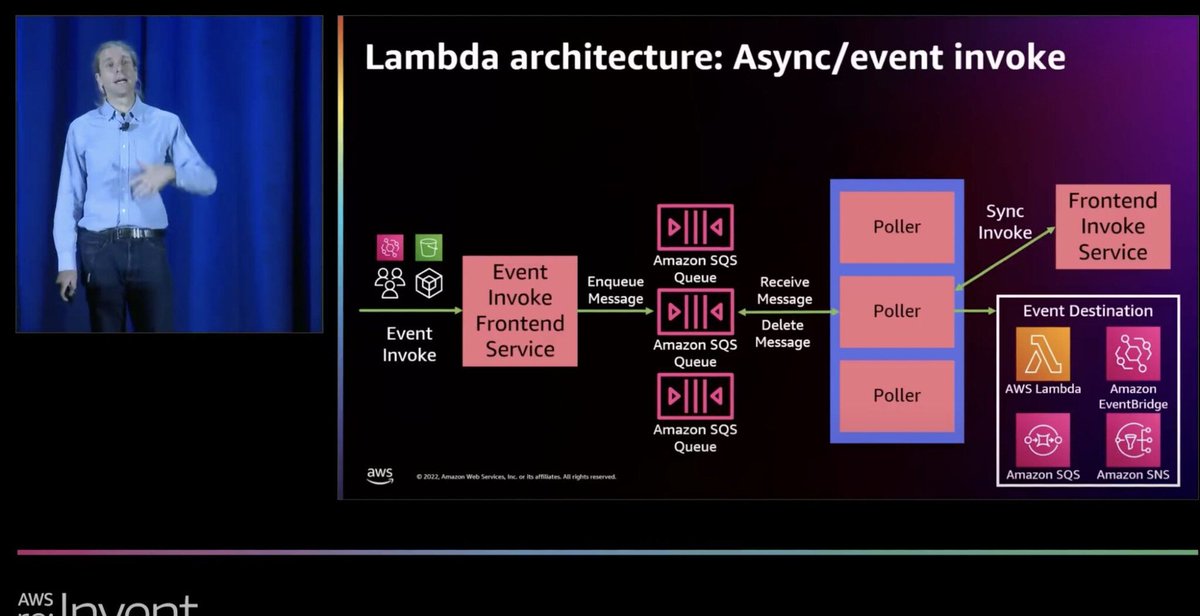Here is one of the most misunderstood aspects of AWS Lambda
|
One of the most misunderstood aspects of Lambda is how throttling applies to async invocations. Or rather, how it doesn't! Every Lambda invocation has to go through its Invoke API [1], whether you're invoking the function directly or through an event source such as API Gateway or SNS. With the Invoke API, you can choose invocationType as either "RequestResponse" (i.e. synchronous) or "Event" (i.e. asynchronous). Synchronous invocationsWith synchronous invocations, throttling limits are checked to make sure you stay within:
However, this is not true for async invocations. Async invocationsWith asynchronous invocations, the Event Invoke Frontend service (see diagram below) accepts the request and passes it onto an internal queue. It does not check the concurrency limits and will succeed even if the function does not have the concurrency to process the request. But that's OK because it does not have to process the request right away, given the asynchronous nature of the invocation.
Instead, concurrency limits are checked when the internal poller attempts to invoke the function synchronously. This means that you will never experience throttling when you invoke a function asynchronously. Even if you set the reserved concurrency to 0 - which will stop the function from running - the "Event" Invoke call will still succeed. But what happens when the internal poller invokes the function synchronously and the function is throttled? In that case, the invocation request is returned to the internal queue and is retried for up to 6 hours. This is described in the official documentation here [3]. Async invocations vs. Async event sourcesAnother important detail to consider is that async event sources such as SNS and EventBridge also invoke Lambda asynchronously. This means, even though they each offer a longer retry period:
But, because async invocations never fail due to throttling, so they count as successful deliveries for SNS and EventBridge. Lambda's Event Invoke Frontend service accepts the request, and any throttling errors will be retried for up to 6 hours ONLY. I asked about this on Twitter, and two of the principal engineers on the Lambda team confirmed my hypothesis above. See their responses here and here. So what?Why do these details matter? Quite a few of you have told me that you prefer SNS -> Lambda over a direct async Lambda invocation because it protects against throttling errors. Good news, given the above, you don't need the SNS topic! (unless you need it for fan-out) This is a good thing because:
You are welcome :-) This follows one of my most important architectural principles and I think you should follow it too. Aren't Lambda-to-Lambda calls an anti-pattern?Yes, synchronous Lambda-to-Lambda calls are an anti-pattern. However, there are valid use cases for asynchronous Lambda-to-Lambda calls. For example, when you offload secondary responsibilities (e.g. analytics tracking) from a user-facing API function to a second function and invoke it asynchronously. This is so that:
These benefits justify the extra cost of invoking a second function instead of doing everything in the API function. Links[1] Lambda's Invoke API [2] AWS re:Invent 2022 - A closer look at AWS Lambda (SVS404-R) [3] How Lambda handles errors and retries with asynchronous invocation |
Master Serverless
Join 17K readers and level up you AWS game with just 5 mins a week.
The DNS failure was the first symptom, not the root cause of the recent AWS outage. The root cause was a race condition in an internal DynamoDB microservice that automates DNS record management for the regional cells of DynamoDB. Like many AWS services, DynamoDB has a cell-based architecture. (see my conversation with Khawaja Shams, who used to lead the DynamoDB team, on this topic) Every cell has an automated system that keeps its DNS entries in sync. That automation system has two main...
AppSync doesn’t allow unauthenticated API calls. To allow users to call your API without first authenticating themselves, you must mimic the behaviour using one of the available authorization methods [1]. In this post, let’s look at three ways to implement unauthenticated GraphQL operations with AppSync and their pros & cons. API Keys To use API keys, you need to: Add an API Key in AppSync. Pass the API Key in the x-api-key header. That’s it! It’s the easiest and most common way to implement...
A common challenge when building APIs is supporting multiple live versions without letting the system turn into an unmaintainable mess. You need to keep older versions running for existing clients, roll out new versions safely, and avoid breaking changes that might take down production. And you need to do all that without duplicating too much infrastructure or introducing spaghetti logic inside your code. There’s no official pattern for versioning APIs in API Gateway + Lambda. API Gateway...

